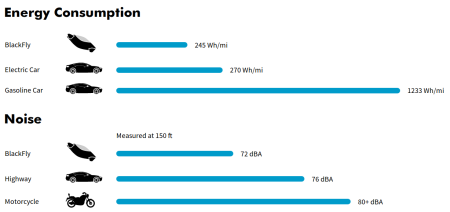
Rolls-Royce EVTOL air taxi concept, launched at Farnborough Air Show July 2018
People have been dreaming of personal flying vehicles since Icarus flew too close to the sun. But there have been fundamental problems to the concept of air taxis and flying “cars”: noise, pollution and the need for air strips included. But now the technology to make the dream possible has arrived: EVTOL.
Electric (or hybrid-electric, or electrically-assisted) Vertical Take-Off/Landing means an air vehicle that has the VTOL characteristics of a helicopter but otherwise flies like a fixed-wing airplane. The VTOL is possible thanks to swivel-wings or swivel engines that are electrically (or hybrid-electrically) powered. This helps beat the noise problem of helicopters, the pollution that a high concentration of conventionally-fuelled aircraft would cause, and the urban airstrips that fixed-wing vehicles would need.
For example, let’s look at the EVTOL air taxi concept that Rolls-Royce unveilled earlier today (16 July 2018) at the Farnborough Airshow. The hybrid aircraft, designed to carry four or five passengers, has an M250 gas turbine which delivers around 500kW of electrical power. This is used to drive six rotors that can provide both lift and propulsion, with the wings tilting forward 90 degrees once sufficient altitude has been reached. Four of the rotors can also fold into the wings, leaving two at the rear to provide thrust at cruising altitude while helping to reduce cabin noise. Top speed is estimated at 250mph and range is predicted to be 500 miles. According to Rolls, an onboard battery will bring additional climb power and will be recharged by the M250 engine.

The Blackfly Personal EVTOL
And this is just four days after Opener announced its single-person EVTOL personal aerial vehicle, Blackfly, hailed as the world’s first ultralight, fixed-wing EVTOL aircraft. The BlackFly Opener is amphibious and is primarily designed as a small grassy area hopper. It can travel up to 25 miles at 62 mph in the US, or over 80 mph elsewhere. And in the US anyone can own and operate a Blackfly – there is no need for formal licensing. And in the pollution stakes: it uses less energy than an electric car, and produces less noise than do petrol-driven cars.

How the Blackfly stacks up on the noise and energy fronts
Unlike Opener, Rolls-Royce produced a concept rather than an actual aircraft. Nevertheless they claim that the concept is based upon technology that either already exists or is currently under development. If a viable commercial model emerges, the company believes the vehicle could be in service by the early 2020s. However there will be a lot of competition in this market: Airbus and Uber have both announced plans, Google’s Kittyhawk is taking orders ; and last year, Dubai staged its first autonomous air taxi trial, and authorities there claim personal air mobility could transform the region over the next five years.
In April 2017 after the first Uber Elevate Summit, Electric VTOL News started a catalogue of EVTOL aircraft – it grew at a rate of about one aircraft per week during the first year, but this has now accelerated to an average rate of two aircraft per week as more aircraft are unveiled and new actors join the sector, and now numbers over a hundred aircraft.
As of June 15, 2018, the site had 45 vectored thrust aircraft listed; 12 lift + cruise configurations; 24 wingless multicopter aircraft; and 23 Hover Bikes/Personal Flying Devices.
In addition, the website now hosts more than 100 news articles and in-depth stories on eVTOL aircraft and developments.
This is an exciting sector and brings ever closer to reality the dream of personal air vehicles – your very own airplane! So keep an eye on the skies!




 Posted by Martin X
Posted by Martin X 












